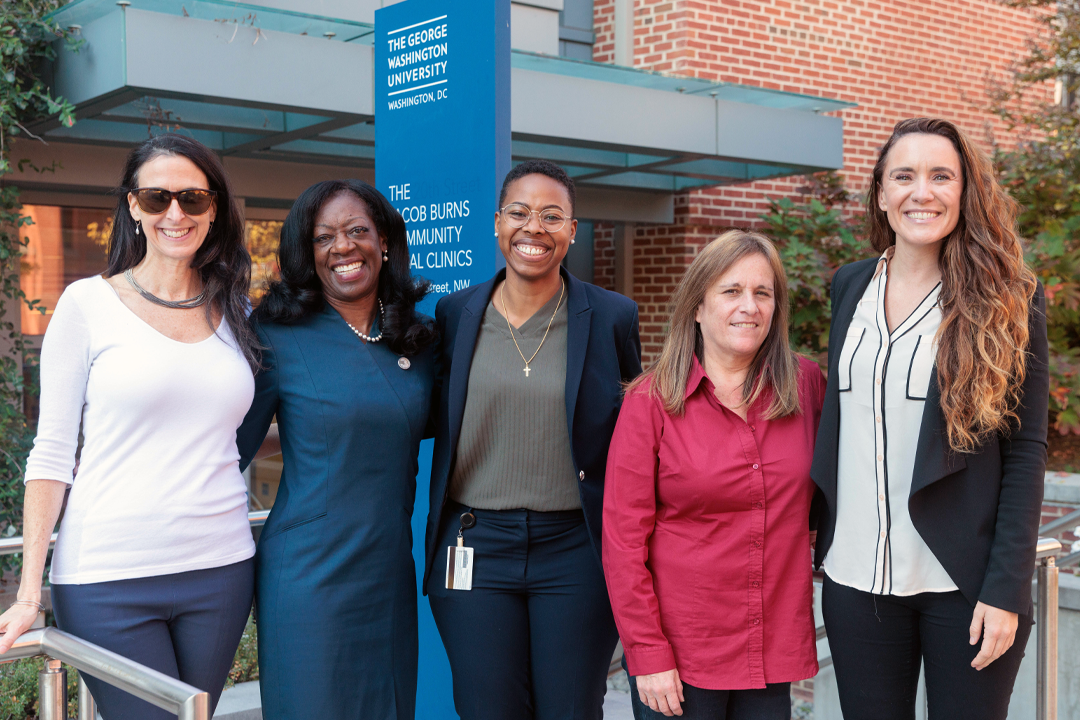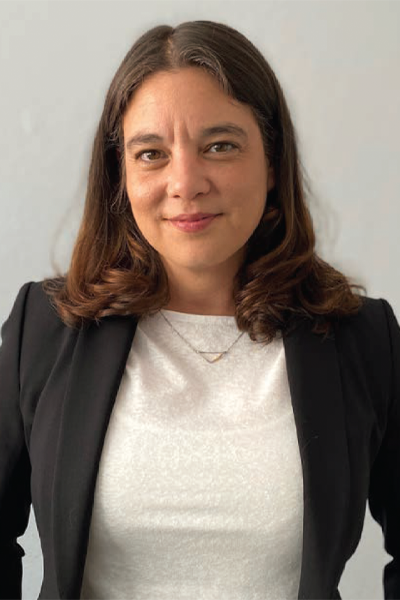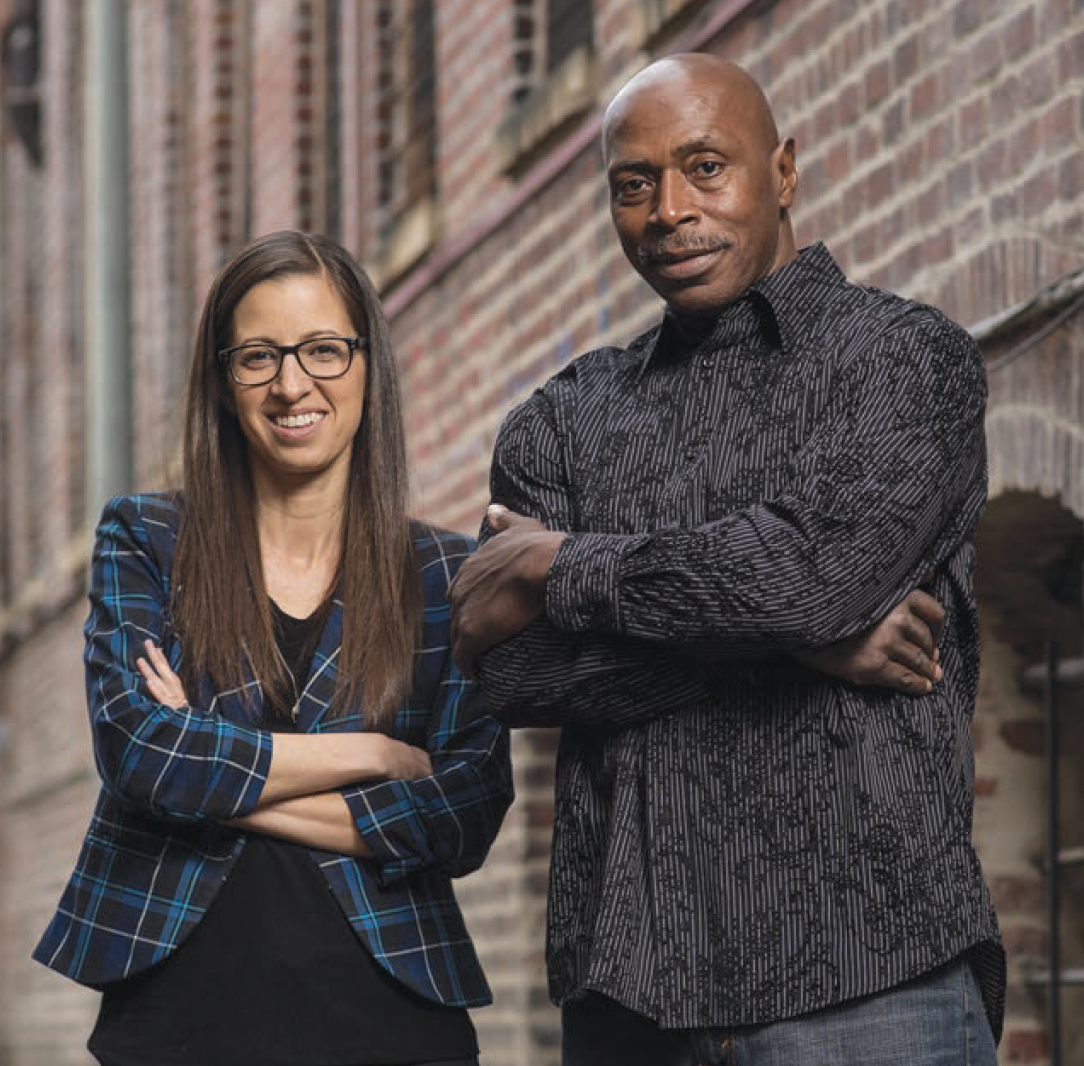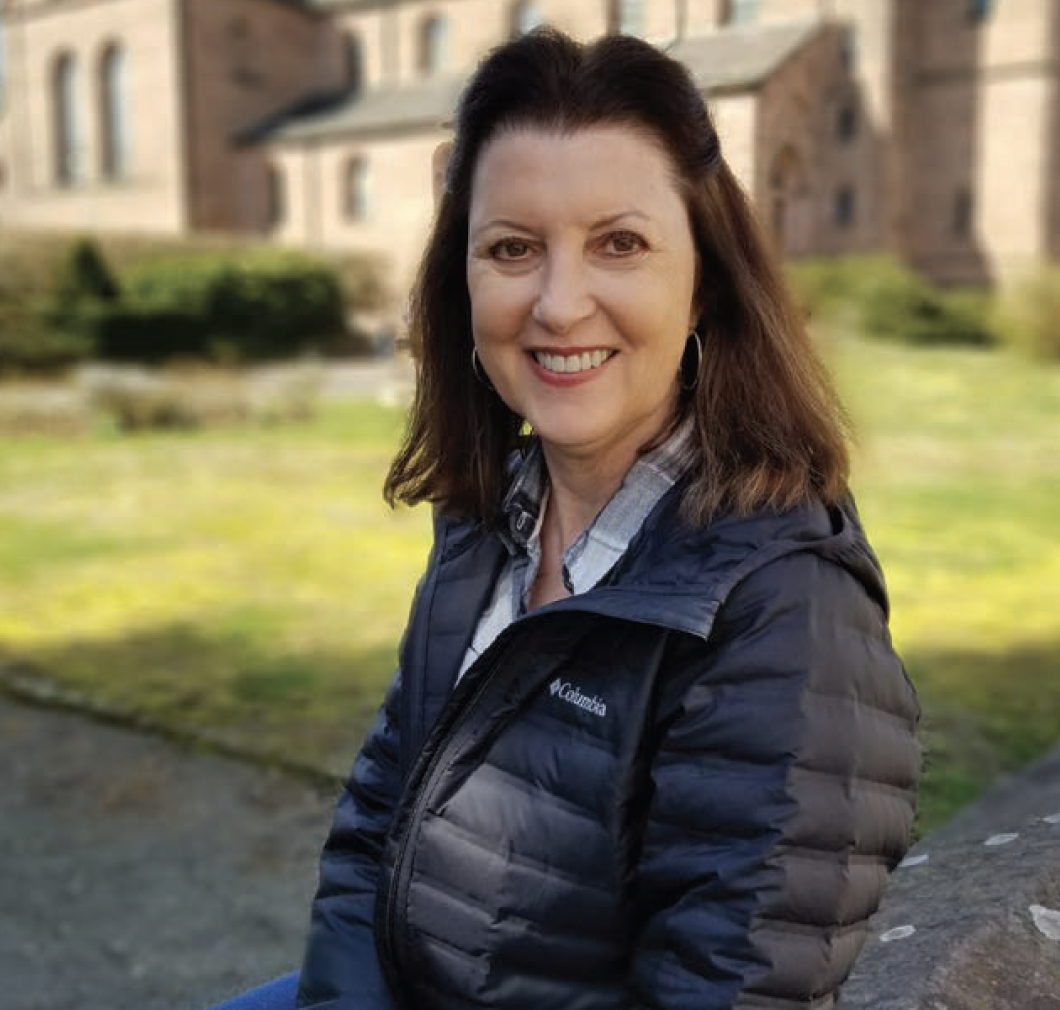By Sarah Kellogg
SINCE 1971, THE GW LAW CLINICS HAVE PREPARED STUDENTS for legal careers by offering them experience serving clients, testing their practical skills, and developing a deeper appreciation of the law. By any measure, the first 50 years have been a resounding success.
Rededicated in 1991, the clinical law program was officially renamed the Jacob Burns Community Legal Clinics, recognizing the generous support of renowned lawyer, philanthropist, and long-time GW trustee Jacob Burns, LLB ’24, Hon. LLC ’70. Today, the thriving operation—originally housed in three closet-sized rooms and a lounge in the long-demolished Bacon Hall, now fills a new, 4,000 square foot, state-of-the-art building on 20th Street, NW.

Laurie Kohn (Clinical Dean), Dayna Bowen Matthew (GW Law Dean), Andrea Willis-Johnson (Managing Attorney), Milagros Tudela (Administrative Supervisor), Bonnie McKintyre (Clinic Social Worker)
“Fifty years is really a moment for us to take stock of all the incredible work that has been done in legal education and in serving our community,” says Laurie S. Kohn, Jacob Burns Foundation Associate Dean for Clinical Affairs, associate professor of clinical law, and director of the Family Justice Litigation Clinic. “What’s so consistent is the enormous contribution we have made and that our students have made to provide access to justice in the District of Columbia and the surrounding region.”
The story of the clinical law program has been written by the dedicated faculty and students who have served D.C.-area and national clients who cannot afford attorneys. The program has also set a new standard for legal policy engagement and advocacy. Student attorneys have participated in public debates on a range of critical legal issues, testifying in Congress and before federal panels.
Varying in purpose, duration, and duties, the clinics offer students a chance to gain real-world experience, which not only enhances their legal education but also the reputation of GW Law as a place where young lawyers are forged through informed instruc- tion, in-depth legal research, and real-world practice.
“I think this anniversary is incredibly significant,” says Jessica K. Steinberg, associate professor of clinical law and director of the Prisoner & Reentry Clinic. “GW has one of the oldest clinical law programs in the country. This is a time of celebration of what we’ve accomplished and a time to reflect on what we want to bring forward over the next 50 years.”
There are many factors that contribute to the success of the clin- ical law program; one of the most prominent is the variety of clinics offered. Second- and third-year students choose from 11 in-house clinics and one outside clinic each semester. From the Public Justice Advocacy Clinic to the Domestic Violence Project to the Small Business & Community Economic Development Clinic, the clinics attract students who are eager to represent clients and serve the law.
“I actually got to interact with clients and develop my own style with respect to clients, doing a cross examination, and being in the courtroom,” says Alfonso Nazarro, a third-year student who was a part of the Vaccine Injury Litigation Clinic in his second year. “I actually got to try cases, and that was a great experience.”
Observers say that one of the achievements of the clinical program over the last five decades is how it often changes the lives of the young people who populate them. Over the years, the number of clinics has expanded to meet the needs of law students burning for real-world experiences in law school. What is most meaningful are the countless stories detailing how this early boots-on-the-ground work has transformed legal careers and lives.
As the clinical program enters its next 50 years, the vision is to grow to ensure that every GW Law student who wants a clinical experience is guaranteed one. “Today, we turn away approximately 50 to 100 students per year who apply to clinical courses because we do not have enough instructors,” says Dean Matthew. On these pages, we present a few of the program’s many success stories and look ahead to an even brighter future.
Immigration Clinic: An Unexpected Detour

SAN FRANCISCO IMMIGRATION JUDGE Elizabeth L. Young, JD ’04, marvels today at the serendipitous turns in her life that began with her time in the Immigration Clinic and set her off on an entirely different course than she had planned.
“I fell in love with immigration law during my clinical program, and it started me thinking about how my career should unfold,” says Judge Young, 44, who now serves as chief judge for the San Francisco Immigration Court. “I was going to be an immigration judge when I was 50. I even beat that timeline.”
Judge Young was appointed to the San Francisco Immigration Court in 2016 and promoted to chief judge in August 2021. From 2004 through 2007, she served as an attorney adviser for the same court.
“The clinic influenced me in many ways, but the thing I
loved about it is the focus on best practices,” says Judge Young, who returned to GW Law to serve as interim director of the Immigration Clinic in 2007-08. “After you graduate from law school, you learn shortcuts. It’s important to know the best way to represent a client at the beginning of your career.”
From 2008 to 2016, Judge Young was an assistant professor at the University of Arkansas Law School where she launched its first immigration clinic. “My time at the GW Law Immigration Clinic prepared me for that role, as it has for everything else in my career,” says Judge Young. “I feel like clinical work should be required for all law students. You get exposed to so many things in a clinic. It can form who you are as an attorney.”
"The clinic influenced me in many ways, but the thing I loved about it is the focus on best practices"
- Judge Elizabeth L. Young
Filling the Gaps
THE RECIPE FOR SUCCESS FOR ANY CLINICAL LAW program has always been the same: Hire talented faculty at the top of their field, immerse students in the law by providing classroom instruction and on-the-job mentoring, and take on a variety of clients who give students a chance to learn at every stage of a case.
Since its creation, more than 6,000 students have participated in GW Law’s clinical law programs, handling high-impact litiga- tion, providing direct representation, and advocating for legal policy initiatives in D.C. and Congress. In the 2020-21 academic year, 160 GW Law students provided 39,438 hours of client services for 94 clients. There were 369 applicants for those 160 slots.
“We want to fill the gaps in our community,” says Professor Kohn. “We want to enhance not just access to justice and a move- ment toward racial justice and equity but also to create in students the habit of being thoughtful, ethical lawyers who can respond to change.”
Change was the watchword during the COVID-19 pandemic. Students faced the gravity of a life-threatening pandemic, whether working to launch a domestic violence help line to assist pro se domestic violence victims file petitions or creating a guide to federal and D.C. area resources to aid neighborhood businesses shuttered by the pandemic.
“Our class was taught on Zoom, and we did our team meetings on Zoom,” says Professor Renée Gentry, a professorial lecturer and the director of the Vaccine Injury Litigation Clinic. “We will never have another year with that many trials. Very rarely as a lawyer will you get to completely plan your life.”
Prisoner & Reentry Clinic: Bringing Michael Home

Professor Jessica Steinberg, director of the Prisoner & Reentry Clinic, and Rudolph Norris, who received clemency in 2017 after decades behind bars thanks to the tireless efforts of two Clinic students.
REAL LIFE AND THE LAW DON’T ALWAYS coalesce, but in the case of “Michael,” a 72-year-old prisoner granted compassionate release in February 2021, the two seemed to meet. After 50 years in prison, and facing the threat of COVID-19, an ailing Michael managed to find freedom with the help of the Prisoner & Reentry Clinic.
The remarkable work of his student lawyers won him compas- sionate release. A second set of students was enlisted to help Michael once he returned home, helping him to transition back into “normal” life by finding a place to live, obtaining an ID, and securing health care.
“I didn’t know we were going to be working with clients who had been in prison for so long,” recalls Daniel Helinek, JD ’21, who spoke to Michael more than a dozen times during his clinical semester. “To be in for five decades, it’s almost impossible to understand it. It really illuminates the people who are in need of our services.”
This was the first time Prisoner & Reentry Clinic students had been asked to extend their assistance beyond winning a legal case. They were now helping a client navigate a difficult reentry into society. Assisting Michael with his basic needs became an act of humanity. And because of limited community resources and no obvious pathway toward housing or income security, the students provided hundreds of hours of post-release support.
“I talked to him three days after he got out,” says Mr. Helinek, who works as a public defender in Loudoun County, Va. “I felt pure joy from him. He had gone for a walk that day and was going to go to the thrift store later.”
For Michael, he felt joy riding the bus for hours into the night, reconnecting with old friends, changing housing frequently, and ruminating over his time in prison. “Michael told us he would be happy, even if he had just one day to live free of prison before he died,” recalls Professor Steinberg. “It was heartbreaking.”
His peripatetic freedom was brief. Michael’s life ended four months after his release. “His friend called me to let me know about his death,” says Mr. Helinek. “There was a moment of tremendous sadness in his dying, and some personal regret of not being able to help him as much as I wanted to. I had really hoped to meet him in person and sit down and talk, but that wasn’t meant to be.”
"I felt pure joy from him. He had gone for a walk that day and was going to go to the thrift store later."
- Jessica K. Steinberg
A Consequential Future
GW LAW ISN’T RESTING ON ITS LAURELS. IT IS hoping to add two new clinical programs in the next 12 months. In fall 2021, the law school launched the Criminal Defense and Justice Clinic (CDJC) where students will represent indigent defendants in misdemeanor cases before the Superior Court of the District of Columbia. In fall 2022, the law school hopes to inaugurate a new clinic focusing on intellectual property to serve those who cannot afford the high cost of legal representation and to further enhance GW Law’s highly rated intel- lectual property curriculum.
“Our vision is to grow and be able to offer a vast number of increased clinic seats to every student who wants to take them,” says Professor Kohn. “We want our students to have the experience of being trained in and being educated in a clinic in order to hone their professional identity and learn the law.”
Most importantly, the future will continue the clinical programs’ emphasis on helping disadvantaged individuals and families and the value of that connection, and the reward that comes from seeing a case through to a satisfactory end.
Vaccine Injury Litigation Clinic: Averting a Dead End

Image Caption (Optional)
HEN ANGELA BARRY OF NICEVILLE, FLA., first spoke with Professor Renée Gentry of the Vaccine Injury Litigation Clinic, she was braced for one more disappointment. She’d been told there was nothing anyone could do legally to help her with her vaccine injury case. She was certain she would hit another dead end. “Professor Gentry told me she could help,” remembers Ms. Barry, a former public school teacher, with a husband and two daughters. “I felt like someone had finally heard me.”
What Ms. Barry learned that day was that she was a victim of a SIRVA or shoulder injury related to vaccine administration. In February 2015, a tetanus shot from a drugstore clinic went from run of the mill to life changing. “Our clients are extraordinarily vulnerable,” says Professor Gentry. “They frequently are not believed by their doctors. They are looking for someone to take them seriously.”
A doctor finally determined that Ms. Barry was injured when the tetanus vaccine was mistakenly injected into the bursa of her rotator cuff, causing a deterioration of the bursa. A combination of one surgery, cortisone shots, and months of physical therapy resulted in tens of thousands of dollars in medical bills and more pain. Professor Gentry’s team of student attorneys was able to secure more than $200,000 to offset her medical costs and potential future expenses because the no-fault National Vaccine Injury Compensation Program determined her injury had been vaccine related.
"Professor Gentry told me she could help. I felt like someone had finally heard me."
- Angela Barry
“Professor Gentry and her students couldn’t take away my physical pain, but financially they made a huge difference in my life,” says Ms. Barry. “If the clinic had been a dead end, I would have let it go and lived unhappily with the medical bills and the pain.”

